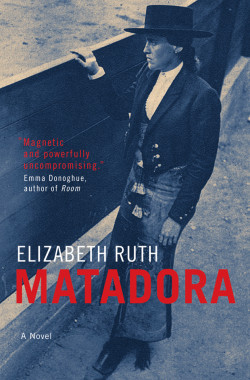Matadora
By Elizabeth Ruth
Comorant
327 pages, $21.95
Reviewed by Chris Fox
Matadora is Elizabeth Ruth’s third novel. It follows Smoke, her second novel, which tells an entransing tale of a small Ontario tobacco town in the late fifties, and Ten Good Seconds of Silence, her first, which now that I’ve read Matadora and Smoke, I will soon seek out. Both previous novels were finalists for a number of literary prizes.
Matadora shifts to 1930s Spain, but Ruth’s interest in history remains. As Smoke took literary and healing energy from the exploits of The Purple Gang, notorious in prohibition era Detroit, Matadora gains gravitas by invoking the Spanish Civil War. Similarly, Ruth remains interested in the gender queer. In Smoke, a transman steals the show, but in Matadora, the ambiguous, ambitious Luna is the show. She is a wonderfully realized character that we first meet, appropriately (The Sun Also Rises) at sunrise, with the silhouette of a Sangre Caste bull behind her. She is leaping from a wall, spurred by the absence (since birth) of her mother, and sure, at that moment, that she can fly.
We are also introduced to Manuel, who acts as Luna’s double and foil throughout the novel, a character device that serves Ruth well. He is the first-born son of the ranchero owner and meant to be a bull-fighter, but he aspires to be a poet – an ambition as unlikely as Luna’s desire to become a matadora. Both seek flight from their given lives and offer each other what help they can. Their bond, like Luna’s wilful talent, is blood-borne, provoking reconsideration of nature/nurture debates.
Ruth has done terrific research, especially into the details of the making of a matadora. She even introduces “anti-taurinos,” early animal rights activists. (Interestingly, the Spanish word implies that they are anti-bull, not anti-bull-fighting, which is indicative of how aficionados (mis)understand the raising, training, and killing of bulls for loving and respecting the animals. Somewhere here lies my only reservation in recommending Matadora. Despite the many clever metaphoric uses of bull-fighting in the novel, the more primary focus is on actual bull-fighting, which I think some readers may find difficult. I myself wondered how I would write about it; however, I did find the novel’s attempt to convey the aficionados’ and matadors’ perspective worthwhile. Daring the bull has a long and mythic cultural history, and Matadora draws on that heritage. When Luna explains the mystery of it, as she often does, I almost understood.
Moreover, in a clever last pass, Ruth has Canada provide Grace, a young Canadian who has come to help fight Franco. Unlike Luna, who spills blood in the ring, Grace transports blood to the front. Of course she is an anti-taurino. Matadora stages a confrontation between what is bright (Luna and her suit of lights) in the darkness that is bull-fighting and the gaze of the New World struggling to understand the Old. Grace is drawn to Luna, but remains judgemental and although the novel offers Luna Grace, Luna chooses to be only matadora. It is enough for her and probably enough for most readers. Ruth has given us a very well-crafted novel.
Chris Fox is a Victoria writer, editor, and instructor.

{ 2 comments… read them below or add one }
Hi there,
Just happened upon this review of my book, Matadora, by Chris Fox. Please extend my gratitude to Chris for a thoughtful review, and for taking the time to invest in my work. All best wishes,
Elizabeth
Hi Elizabeth. So glad you liked the review & will do!